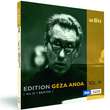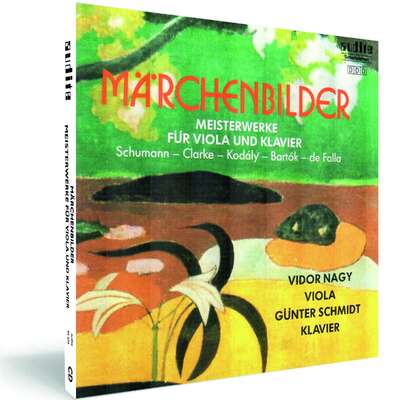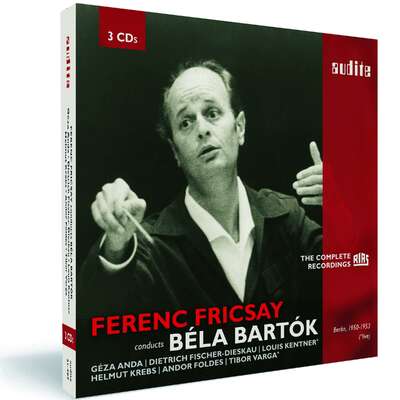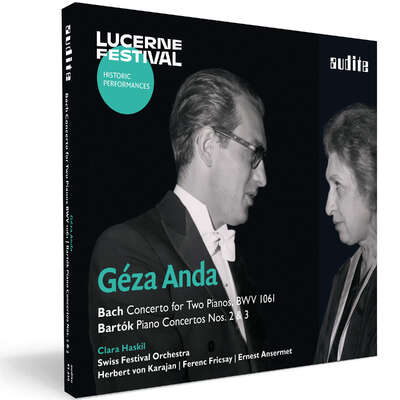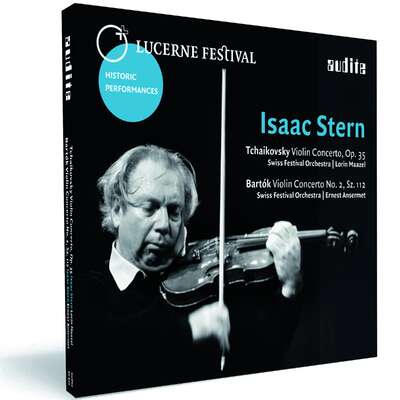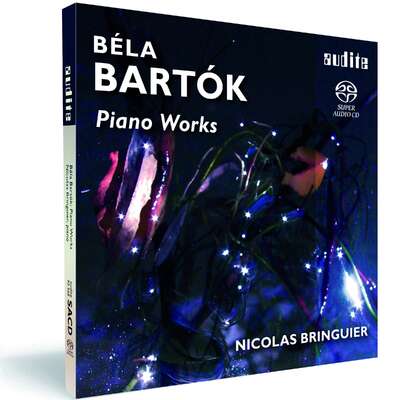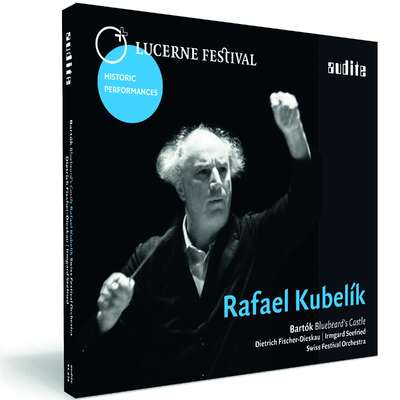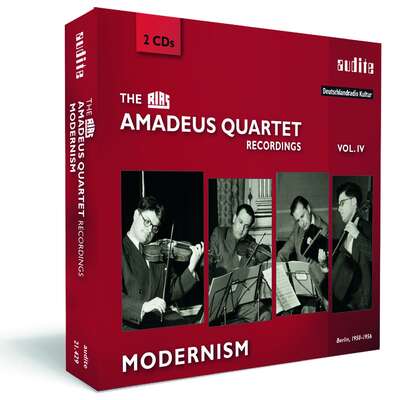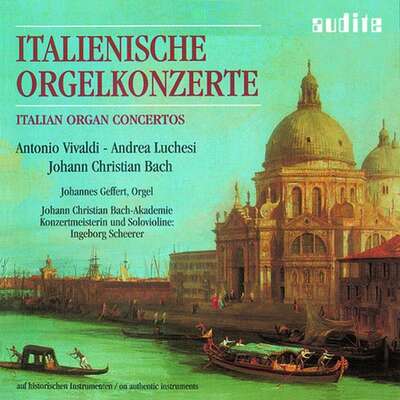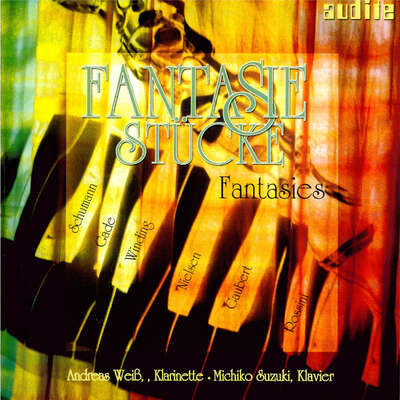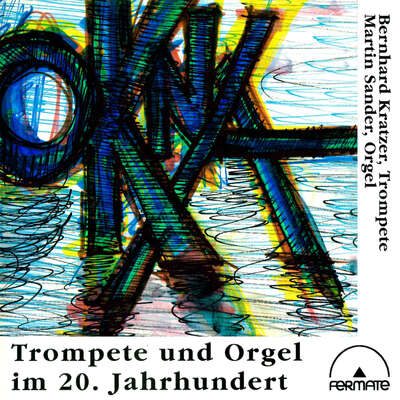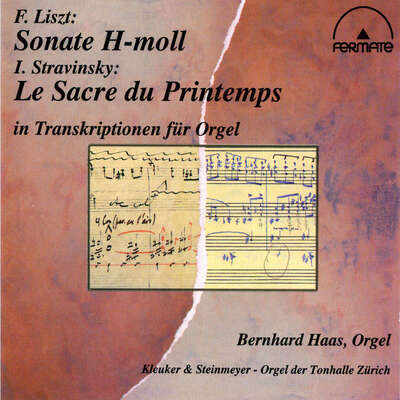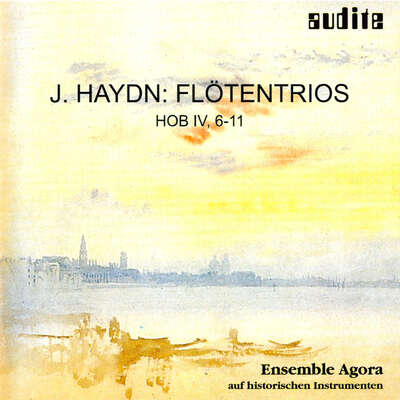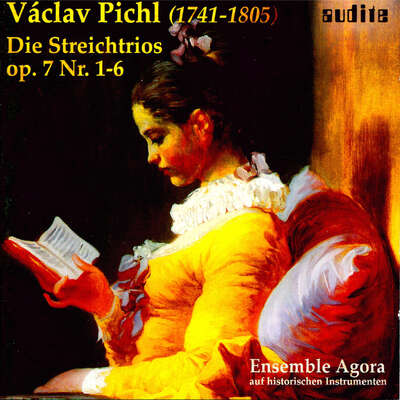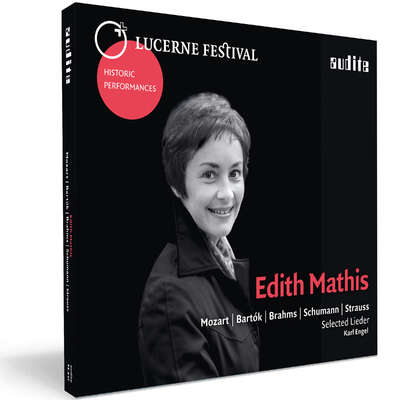
This fourth and final volume of the Géza Anda edition of recordings from the archives of the WDR, issued by Audite, culminates in music by Béla Bartók to which Géza Anda was devoted from the beginning of his career. Bartók’s piano concertos, the first two of which are presented here...more
"Perfect synchronicity of parts makes this seamless experience an especially rewarding moment by which to celebrate the troubadour’s art of Geza Anda." (audaud.com)
Track List
Details
| Edition Géza Anda (IV) – Bartók | |
| article number: | 23.410 |
|---|---|
| EAN barcode: | 4022143234100 |
| price group: | BCA |
| release date: | 2. April 2008 |
| total time: | 104 min. |
Bonus Material
Informationen
This fourth and final volume of the Géza Anda edition of recordings from the archives of the WDR, issued by Audite, culminates in music by Béla Bartók to which Géza Anda was devoted from the beginning of his career. Bartók’s piano concertos, the first two of which are presented here as impressive live recordings from 1952 (with Ferenc Fricsay) and 1957 (with Michael Gielen), both with the Cologne Radio Symphony Orchestra, achieved their final public breakthrough thanks to Anda’s efforts. His enthusiasm for chamber music as well as his gift in performing together with world-famous Hungarian colleagues are revealed in two recordings from 1953. In the Sonata for two pianos and percussion his partner on the second piano was no lesser than Georg Solti, and in Contrasts Anda performs together with the violinist Tibor Varga and the clarinettist Paul Blöcher. To bring this edition to a close, Géza Anda can be heard once more as a soloist in a rousing performance of the Suite for piano op 14 from 1955.
Reviews
France Musique
| mercredi 9 décembre 2009 | December 9, 2009
BROADCAST Concert de l'après-midi
Identités hongroises: Liszt, Kodály, Bartók
Sendebeleg siehe PDF!Mehr lesen
Frankfurter Allgemeine Zeitung | 28. Juli 2009, Nr. 172, S. 30 | Eleonore Büning | July 28, 2009
Ein Troubadour des Klavierspiels
Géza Anda ist nicht nur das probate Vorbild bei Mozart und Bartók. Schon vor fünfzig Jahren spielte er Schumann, Liszt, Chopin, Rachmaninow klar und leuchtend
Donnern genügt nicht. Sicher braucht es immer auch die Vehemenz einesMehr lesen
Fanfare | Issue 32:5 (May/June 2009) | James H. North | May 1, 2009
These are first CD issues of radio recordings from WDR Cologne. Most of these performers are Hungarian musicians who had studied in Budapest in theMehr lesen
The First Piano Concerto, led by Gielen, does not come off as well in this live performance as in the studio recording. Tempos are similar—the Andante a bit slower here—but the Cologne orchestra lacks the polish of Fricsay’s Berlin Radio Symphony Orchestra, which he had honed into a superb ensemble rivaling that city’s Philharmonic. The Cologne brass have some awkward moments. This monaural radio recording is nowhere near as clear as DG’s stereo one, and many orchestral details fail to surface.
The Second Concerto, led by Fricsay, is better on all counts. The notes say that Anda performed this work more than 300 times, and this live performance at Salzburg was one of his first. His playing has moments of extra frisson, and the accompaniment is fine, although there are a few woodwind shrieks and brass blasts—this was difficult music for orchestras as well as pianists in the 1950s. Things get a tad messy at one moment in the Presto section of the slow movement. Anda may not have had the chops of Pollini or Richter, but his Bartók was more colorful than that of either. This 1952 live recording is much cleaner than the 1957 radio one of the First Concerto. Balances are quite different than in the 1959 stereo; here the piano is in front of the orchestra, there it is more integrated into it. Although DG’s early stereo recording remains preferable, it does suffer from poorly judged post-production: when the focus shifts to one side of the orchestra to hone in on some detail, the piano slides across the soundstage.
This recording of Contrasts is wonderful. Varga, Blöcher, and Anda set a daring tempo for the Verbunkos—more than 10 percent slower than Szigeti, Goodman, and Bartók—and they are not afraid to screech and scratch. The result has a dusky folk flavor beyond any performance I have heard. Varga is mesmerizing, his almost demonic pizzicatos and double stops keeping the intensity level at a peak. Blöcher—WDR Cologne first clarinet—also seems to the manner born, playing as if he were at a village fair rather than in a big-city studio. They turn Contrasts into a masterpiece.
That Anda was a major force in the interpretation of Contrasts is reinforced by his performance of the op. 14 Piano Suite. Again tempos are relaxed, the virtuosic side of the writing played down (but never short-changed), with no loss of intensity. In two other performances at hand, Murray Perahia plays with crystal-clear precision, with every note sounding, but—heard next to Anda—the result is clinical; Dezső Rankí, too, produces little atmosphere, making the Suite seem mere digital exercises. Anda makes these four movements sound like Bartók.
The Sonata for Two Pianos and Percussion is often played as a pure virtuoso showpiece, fast and furious and damn the subtleties. This is a thoroughly musical performance, and a most rewarding one. That the pianists are not always together doesn’t matter one whit; it suggests an improvisatory performance relying on the inspiration of the moment. Again, color and atmosphere are brought to the fore, as opposed to sheer technique. I don’t mean to defend a sloppy performance—which this is not—but rather to revel in the spirit and freedom found here.
The recorded sound throughout the second disc is excellent, its monaural character no limitation in any way. Whereas early performances of Schoenberg were universally dreadful, and those of Stravinsky inconsistent at best, the 1950s witnessed the peaks of Bartók performances, many of them by these musicians. This issue is to be treasured, in particular for the stunning Contrasts, which makes it Want List material.
klassik.com | Dezember 2008, CD-Neuerscheinungen online | Aron Sayed | December 8, 2008 | source: http://magazin.k... Bartók aus den Fünfzigern
Seit Beginn 2008 erscheint bei Audite die ‚Edition Géza Anda’ mitMehr lesen
Neue Musikzeitung | 12/08 - 57. Jahrgang | Hanspeter Krellmann | December 1, 2008
Von der poetischen Auflösung der Musik
Géza Anda beim WDR Köln: zur neuen Gesamt-Edition bei audite
Er [Geza Anda] verfügte geradezu beneidenswert über die Begabung, Musik jeder Ausrichtung poetisch aufzulösen und ihr auf diese Weise eine nach innen wirkende Sensation zu sichern.Mehr lesen
www.ClassicsToday.com | October 2008 | Jed Distler | October 31, 2008
Audite's third of four double-CD sets devoted to Géza Anda's Cologne RadioMehr lesen
Die Presse | 20.10.2008 | Schaufenster | Wilhelm Sinkovicz | October 20, 2008 Mozart erlesen, Bartók kongenial
Als Bartók-Interpret ist er eine Legende, als feinsinniger MozartspielerMehr lesen
Gramophone | October 2008 | October 1, 2008
New slants on familiar interpretations
Karaian's Verdi Requiem and Anda's Bartok Second Piano Concerto
Four days before Furtwängler died in Baden-Baden (on November 30, 1954) his arch-rival Herbert von Karajan was conducting Verdi's Messa da Requiem atMehr lesen
Still, I doubt if Karajan conducted Verdi's Requiem quite as often as Géza Anda played Bartók's Second Piano Concerto, which was more than 300 times. Volume 4 of Audite's unmissable Géza Anda “Edition” includes a light and fiery 1952 Salzburg performance under Fricsay, troubled only occasionally by some quirky balancing. The First Concerto (1957) under Michael Gielen, which is among the most playful versions I've ever heard, is rather better in that respect. The second disc includes a work that I don't recall ever hearing Anda play, the Contrasts, where the earnest violinist is Tibor Varga and the clarinettist the WDR Symphony Orchestra's Paul Blöcher. Here, as in the wonderful Suite, Op 14, Anda's performance combines flexibility – it's almost rhapsodic at times – with an acute feeling for colour and rhythm. Another Anda “first”, at least as far as CD is concerned, is the Sonata for Two Pianos and Percussion where his duet partner is none other than Georg Solti.
Again, tone colouring and nuance are the principle virtues and if the first movement's shifting rhythmic patterns are sometimes less than watertight, a sense of elemental energy more than compensates. The sound quality is fairly good and I would enthusiastically urge all Bartókians to invest without delay. These sorts of releases tend to have rather short shelf lives.
Die Presse | 18. September 2008 | Wilhelm Sinkovicz | September 18, 2008
Geza Anda war einer der bedeutenden Pianisten des 20. Jahrhunderts – undMehr lesen
Fono Forum | September 2008 | Ingo Harden | September 1, 2008 Von Paderewski bis Gulda
Immer mehr alte Klavieraufzeichnungen auf Schellack, Klavierrollen und Rundfunkbändern finden den Weg in die CD-Kataloge. Eine Revue der wichtigstenMehr lesen
Um mit einer angreifbaren, aber empirisch bewährten Hypothese zu beginnen: Wer mit Lust und Freude Platten sammelt, den wird es früher oder später auch zu „historischen“ Aufzeichnungen ziehen: weil die Beschäftigung mit neuen Aufnahmen über kurz oder lang neugierig macht auf das, was vorher war. Und weil Emil Berliners und Edwin Weites Erfindungen die Möglichkeit eröffnet haben, sich jetzt immerhin schon in die akustische Vergangenheit eines ganzen Jahrhunderts zurückzutasten.
Allerdings muss der Hörer beim Abhören alter Aufnahmen kompensieren können. Denn erstens bewahren besonders die frühen Schellacks wegen ihres begrenzten Klangspektrums und Pegels nur ein farbschwaches Abbild der tönenden Realität. Und zweitens waren die musikalischen Vorstellungen unserer Altvorderen noch stark vom ganzheitlichen Eindruck jeder Aufführung bestimmt. Vom akustischen Erscheinungsbild erwartete man offenbar bis in die 1940er Jahre noch nicht zwingend Perfektion nach heutigen Vorstellungen; frühere Konzertbesucher waren besser darauf eingerichtet, sich Fehlendes und Intendiertes ergänzend aus den optischen Signalen des Interpreten zu erschließen.
[…]
Sonderstatus besitzt dagegen die Berliner Aufnahme des c-Moll-Konzerts mit dem 75-jährigen Wilhelm Kempff: vorhersehbar gänzlich unheroisch, aber immer luzide geistreich und spontan. Und was für ein guter Dirigent war Maazel, als er noch nicht so deutlich zeigte, dass er sich dessen allzu sehr bewusst war!
Die Audite-Musikproduktion Ludger Böckenhoffs, dem diese Erschließung zu danken ist, stellt gleichzeitig eine ausführliche „Edition Géza Anda“ vor, die auf acht CDs Aufnahmen aus dem WDR-Archiv, vorwiegend aus den 1950er Jahren, publik macht. Sie ist wertvoll vor allem durch die Interpretationen der großen Romantiker-Werke, die der Dreißiger Anda fabelhaft „werktreu“ konzentriert und mit hervorragendem (und hervorragend eingefangenem!) Ton spielte. Die Edition ist das überfällige Gegengewicht zur Mozart-Serie der DG, die das gängige Anda-Bild bisher einseitig einfärbte.
CD Compact | Septiembre 2008 | Verónica Maynés | September 1, 2008 Audite Edition Géza Anda
Si el lector es uno de esos melómanos sibaríticos y exigentes, que estáMehr lesen
Audiophile Audition | August 22, 2008 | Gary Lemco | August 22, 2008
The last of the four volumes devoted to Hungarian piano virtuoso Geza AndaMehr lesen
BBC Music Magazine | August 2008 | Michael Tanner | August 1, 2008
In the fairly early days of LP, one of the top recommendations was the three Bartók piano concertos, then considered as virtually contemporary music,Mehr lesen
On the second disc, we have what was long one of Bartók's most popular works, the clarinet part of Contrasts being written for Benny Goodman. The performance here is less evidently popular in manner, but fits in well with the asperities of the Suite for Piano and the Sonata for two Pianos and Percussion, in which Anda's partner is his fellow-countryman Solti whose approach is a good deal more percussive than Anda has previously been in Bartók, though he shows he can adapt as the piece requires. For anyone who wants a conspectus of the composer's writing for the piano, with or without other instruments, this set is ideal.
Arte | 8. Juli 2008 | Mathias Heizmann | July 8, 2008 Géza Anda
Eine Handvoll CDs, ein CD-Player, ein paar Liter Benzin, und es kannMehr lesen
Diapason | juillet-août 2008 | Etienne Moreau | July 1, 2008
Les archives des studios de la Radio de Cologne et de son orchestre (aujourd'hui WDR Sinfonieorchester Köln) n'ont pas fini de nous livrer leursMehr lesen
Le volume suivant comporte un Concerto n° 1 de Beethoven en public, volontaire et lumineux, et surtout deux sonates qui font regretter que Geza Anda n'ait pas persisté dans la voie du Maître de Bonn, tant le résultat est convaincant par sa clarté et sa finesse. La sonate de Liszt et la Sonate n° 3 de Brahms sont l'occasion de montrer quel grand pianiste il fut, attiré par la lumière des aigus comme dans des Intermezzi d'un Brahms chauffant ses vieux os au soleil, ici magnifiquement et sobrement restitués.
Les Schumann (Vol. III) sonnent juste, comme chaque fois avec Anda, même si on peut leur préférer les enregistrements commerciaux, plus aboutis, publiés chez Deutsche Grammophon quelques années plus tard – Carnaval excepté. Les Préludes de Chopin sont d'un classicisme et les Etudes d'une épure – une seule et même grande arche – qui en disent long sur l'intelligence du style et sur les capacités intellectuelles et instrumentales du personnage.
Le dernier volume, consacré à Bartok, montre Geza Anda dans son élément, qu'il s'agisse des concertos, fins et aériens (particulièrement le deuxième avec Fricsay), ou dans la Suite op. 14 aux harmonies vif-argent, comme improvisée avec ses allures de folklore inventé. La Sonate pour deux pianos et percussions en compagnie de Solti est passionnante tandis que les Contrastes revendiquent leur modernité avec une clairvoyance qui achève de convaincre, s'il était besoin, de l'immensité du talent d'un artiste disparu bien trop tôt.
Crescendo Magazine | N° 94 - Été 2008 | Bernard Postiau | July 1, 2008 Une édition Geza Anda chez Audite
On ne louera pas assez l'éditeur Audite de consacrer une série de huitMehr lesen
Scherzo | Julio 2008 | Rafael Ortega Basagoiti | July 1, 2008
De Pianistas: Géza Anda
Audite (distribuidor Diverdi) edita una colección en cuatro volúmenes, cada uno con dos discos, dedicada al pianista húngaro Géza Anda.
El volumen 1 (Audite 23.407) contiene obras de Mozart (Conciertos n°sMehr lesen
Musica | musica 197, giugno 2008 | Riccardo Risaliti | June 1, 2008
Il tempo che passa inesorabile livella e oscura, indebolendo i ricordi. ChiMehr lesen
Pizzicato | Juni 2008 | Alain Steffen | June 1, 2008 Unschätzbare Anda-Sammlung
Da es nicht sonderlich viele Aufnahmen des genialen ungarischen Pianisten Géza Anda gibt, besitzt diese Hommage für den Sammler einen unschätzbarenMehr lesen
Auch bei Chopin findet der Pianist die musikalische Wahrheit hinter der Virtuosität und beweist, dass die 24 Préludes bzw. die 12 Etudes des polnischen Meisters alles andere als Salonstücke sind. Diskutabler dagegen scheint mir Andas Annäherung an Schumann. Anstelle von Fantasie setzt Anda größtmöglichen Ernst, was allerdings Stücke wie Kreisleriana, Symphonische Etuden oder Carnaval nicht immer ins optimale Licht rückt. Somit bleiben die Schumann-Werke in der Aussage etwas akademisch, wenn Anda spieltechnisch auch hier wieder eine Meisterleistung bietet.
Die vierte Doppel-CD ist Werken von Bela Bartok gewidmet und ist die vielleicht aufregendste Publikation der Serie. Anda spielt hier die beiden Klavierkonzerte, Nr. 1 unter der Leitung von Michael Gielen, Nr. 2 unter Ferenc Fricsay, mit dem er ja einige Jahre später alle drei Konzerte für Deutsche Grammophon aufgenommen hat. Andas frische und direkte Annäherung dieser früheren Aufnahmen zeigt den Pianisten weniger auf der Suche nach Wahrheiten als in der Auseinandersetzung mit Klang und Struktur. Somit wirken beide Konzerte zugänglicher, zumal sowohl der junge Gielen wie auch Fricsay mit der gleichen Stringenz vorgehen wie der Solist. Georg Solti ist Andas Partner in der Sonate für zwei Klaviere und Schlagzeug, ein rares historisches Dokument und darüber hinaus in einer dynamischen und vollblutigen Interpretation. Sehr schön auch die Klaviersuite op. 14, die Anda als einen genuinen Bartok-Interpreten ausweist, sowie die weniger bekannten 'Kontraste für Klarinette, Violine und Klavier' mit u.a. dem hervorragenden Tibor Varga.
www.critic-service.de | 35 | Christian Ekowski | May 7, 2008
Die Dokumentation mit Einspielungen des Pianisten Géza Anda war notwendig.Mehr lesen
Piano News | 3/2008 - Mai/Juni | Carsten Dürer | May 1, 2008
Gleich zwei Reihen von CDs mit Aufnahmen des legendären ungarischenMehr lesen
Diverdi Magazin | N° 168 / marzo 2008 | Pablo-L. Rodríguez | March 1, 2008
El camaleón del piano
Audite lanza una impresionante colección In dedicada al eximio pianista húngaro-suizo Géza Anda
Géza Anda (1921-1976) llegó a hacer planes para dirigir una Tosca de Puccini poco antes de su muerte. ¿Sorprendente? Pues no, porque Anda, ademásMehr lesen
En realidad, existe tan sólo una monografía sobre este gran pianista suizo de origen húngaro que fue publicada por Hans-Christian Schmidt en 1991 bajo el curioso y objetivo título de Geza Anda: Sechzehntel Sind Auch Musik! Dokumente Seines Lebens (Zúrich: Artemis & Winkler). Se trata de una recopilación de comentarios y documentos encaminada a profundizar en la filosofía interpretativa de Anda que nació bajo el auspicio del concurso pianístico trienal que lleva su nombre en la capital suiza. En ella encontramos muchas claves para entender el arte de Anda (o "su espíritu", como lo denomina Schmidt) que parten de la idea de que su concepción de la música iba más allá de los problemas técnicos de su instrumento o de las limitaciones de un repertorio concreto. De hecho, el fin último de su interpretación pretende alcanzar el nivel dialéctico para presentar un texto objetivo por medios subjetivos, y ello es lo que le permite alcanzar un perfecto dualismo (imposible para otros pianistas) entre la pasión y robustez propias de Florestán y el intimismo lírico de Eusebius en sus interpretaciones de Schumann o le ayuda a encontrar la claridad necesaria para Mozart como resultado de un acercamiento muy profundo e intelectual a este compositor, o incluso lograr el equilibrio necesario en Bartók al atender no sólo a lo escrito en sus partituras como compositor sino también a las particularidades de él como pianista.
Y es que para Anda tocar el piano era una forma de intelectualidad y de reflexión filosófica. A diferencia de otros pianistas, él no fue un niño prodigio y quizá ello le permitió concentrarse más en el enriquecimiento de su personalidad artística que en el mero fortalecimiento de sus dedos. En esto último encontraría apoyo tanto en su maestro, Ernö von Dohnanyi, como también en varios colegas mayores como Clara Haskil, Alfred Cortot o Edwin Fischer, o incluso también en el filósofo Pierre Souvchinsky. Desde luego, la principal faceta de su arte reside en la capacidad innata que alcanzó Anda para adaptar su interpretación al estilo de cada compositor, pues prácticamente nunca uno encuentra en un mismo pianista acercamientos tan válidos y profundos a compositores y estilos tan diversos.
Ciertamente, la discografía de Géza Anda ha aumentado bastante en los últimos años. Lanzamientos de Testament, Hunt, Orfeo, BBC Music, Tahra, Idis, Col legno, Archipel o Golden Melodram han engrosado la lista de sus registros fonográficos a partir de archivos radiofónicos, que se suman a sus registros oficiales para EMI, DGG y RCA disponibles hoy en su gran mayoría. Sin embargo, muy pocos sellos han reparado en lo conservado de Anda en las corporaciones radiofónicas de la antigua República Federal alemana (la NDR, WDR, SWR, SR, BR, HR y la RIAS berlinesa) o, por lo menos, desde la frustrada edición en LP dedicada a este pianista por Ariola-Eurodisc en los setenta. Audite nos redescubre la figura de Géza Anda centrándose tan sólo en uno de estos archivos, el de la Westdeutscher Rundfunk de Colonia (WDR), y publicando en cuatro entregas de dos discos un total de veintidós obras concertantes, solistas y camerísticas de Mozart, Beethoven, Brahms, Liszt, Schumann, Chopin y Bartók en su mayoría muy representativas del arte de Anda. Todos son registros inéditos en CD, realizados entre 1952 y 1969, cuya calidad va de lo aceptable a lo excelente, debido al buen estado de las cintas conservadas, a los nombres de los responsables técnicos de las mismas (en especial a Hans-Georg Daehn y a Heinz Oepen) y también a la labor de remasterización de Stephan Schmidt.
El primer volumen se dedica a Mozarr y en él encontramos cuatro conciertos muy característicos del repertorio de Anda junto a la rareza de una sinfonía interpretada bajo su dirección. En el Concierto n° 23 y la Sinfonía n° 28, Anda dirige a la Camerata Academica de Salzburgo, una formación con la que dio el salto de tocar dirigiendo en 1960, consiguiendo materializar con ellos su Mozart elegante, cantable y encantador (aderezado aquí con cadencias propias) y con la que grabó la pionera integral concertante para piano del salzburgués en los sesenta para DGG (siguiendo el ejemplo y la influencia de Edwin Fischer). No obstante, además de sus interpretaciones dirigiendo (se incluye además otra del Concierto n° 20 con la orquesta de la radio) sus colaboraciones con otros directores también fueron fructíferas, como queda patente en el mágico Andante del Concierto n° 21 dirigido por un inspiradísimo Joseph Keilberth en 1956.
El segundo volumen se consagra a Beethoven, Brahms y Liszt. Para empezar, Anda no fue un pianista especialmente beethoveniano, pues tan sólo tocó y grabó cinco sonatas y cuatro de sus conciertos (además de las Variaciones Diabelli y el Triple Concierto), aunque ello no quiere decir que su Beethoven sea menos interesante. Sin duda, entre lo más destacado de este volumen se encuentra su vienesa interpretación de su Primer concierto pianístico, tocando y dirígiendo en 1969, junto a una de las versiones más concentradas, bellas y misteriosas del Largo e mesto de Sonata n° 7, registrada en 1955. Las grabaciones intimistas de Brahms se suman a las realizadas en los cincuenta para EMI (Testament) y la gran sorpresa la encontramos en la Sonata de Liszt de 1955, que deja a un lado su registro del año anterior (Testament) y ahonda en lo narrativo, exquisito y dramático de esta música.
El tercer volumen incluye Otras dos especialidades de Anda: Schumann y Chopin. Sus versiones del primero son hoy todavía muy admiradas, especialmente por lo que tienen de mixtura entre la austeridad y objetividad clásica y la sensación de fluir continuo, de libertad, en una palabra. Al mismo tiempo, en sus interpretaciones destaca un transfondo muy polifónico y contrapuntístico, que supone llegar a Schumann y a Chopin desde Bach. En cierto modo, si en la idea de tocar y dirigir Mozart hay una clara influencia de Fischer, aquí encontramos la huella de Cortot (en todos ellos estaría también la de Haskil). Ninguna de las versiones de la Kreisleriana, los Estudios sinfónicos o el Carnaval, o de los Estudios y Preludios de Chopin, tienen nada que envidiar a sus famosos registros de los cincuenta (Testament) o los sesenta (DGG), y aquí Anda es el verdadero paradigma de un artista universal que "da cuenta de la música por sí misma", como dijo de él el filósofo Gabriel Marcel.
Finalmente, el cuarto volumen se dedica al compositor donde las interpretaciones de Anda siguen siendo más influyentes: Bela Bartók. Hoy nadie duda de que Géza Anda fue quien introdujo en el repertorio los tres conciertos pianísticos de Bartók, que tocó cientos de veces (incluso los tres en la misma velada como atestigua el impresionante concierto muniqués de 1957 publicado por Col legno) y grabó brillantemente junto a Ferenc Fricsay entre 1960 y 1961 (DGG). Pues bien, en este disco Audite publica el primer encuentro entre ambos artistas, que tuvo lugar en Salzburgo en 1952 y que se saldó con la versión más rapsódica, fresca y neoclásica del Concierto n° 2 del compositor húngaro (en los archivos de la WDR hay otro registro posterior de ambos). El resto no desmerece lo histórico de este registro, especialmente al incluir dos sorprendentes tomas camerísticos de Anda de Contrastes y de la Sonata para dos pianos y percursión realizados en 1953 en colaboración con viejos compañeros de estudios y amigos de su Hungría natal como Tibor Varga y Georg Solti. Y es que, según parece, hasta 1976 – el año de su muerte – Anda no descubrió su vocación tardía por la música de cámara, tocando en Innsbruck el Quinteto "La Trucha" de Schubert. Si a esto sumamos sus proyectos como director de orquesta está claro que su prematura muerte nos privó de Anda para rato.
